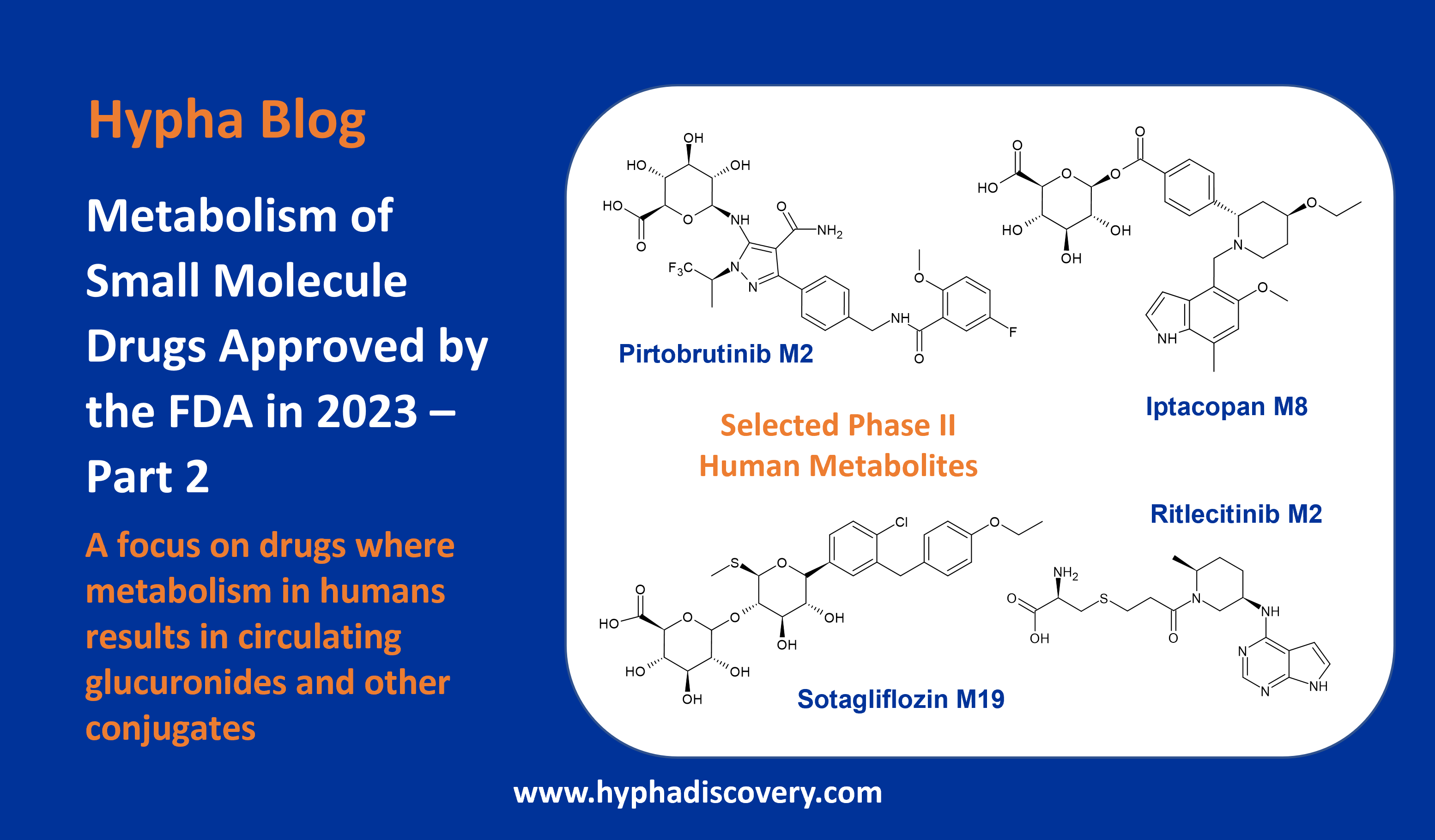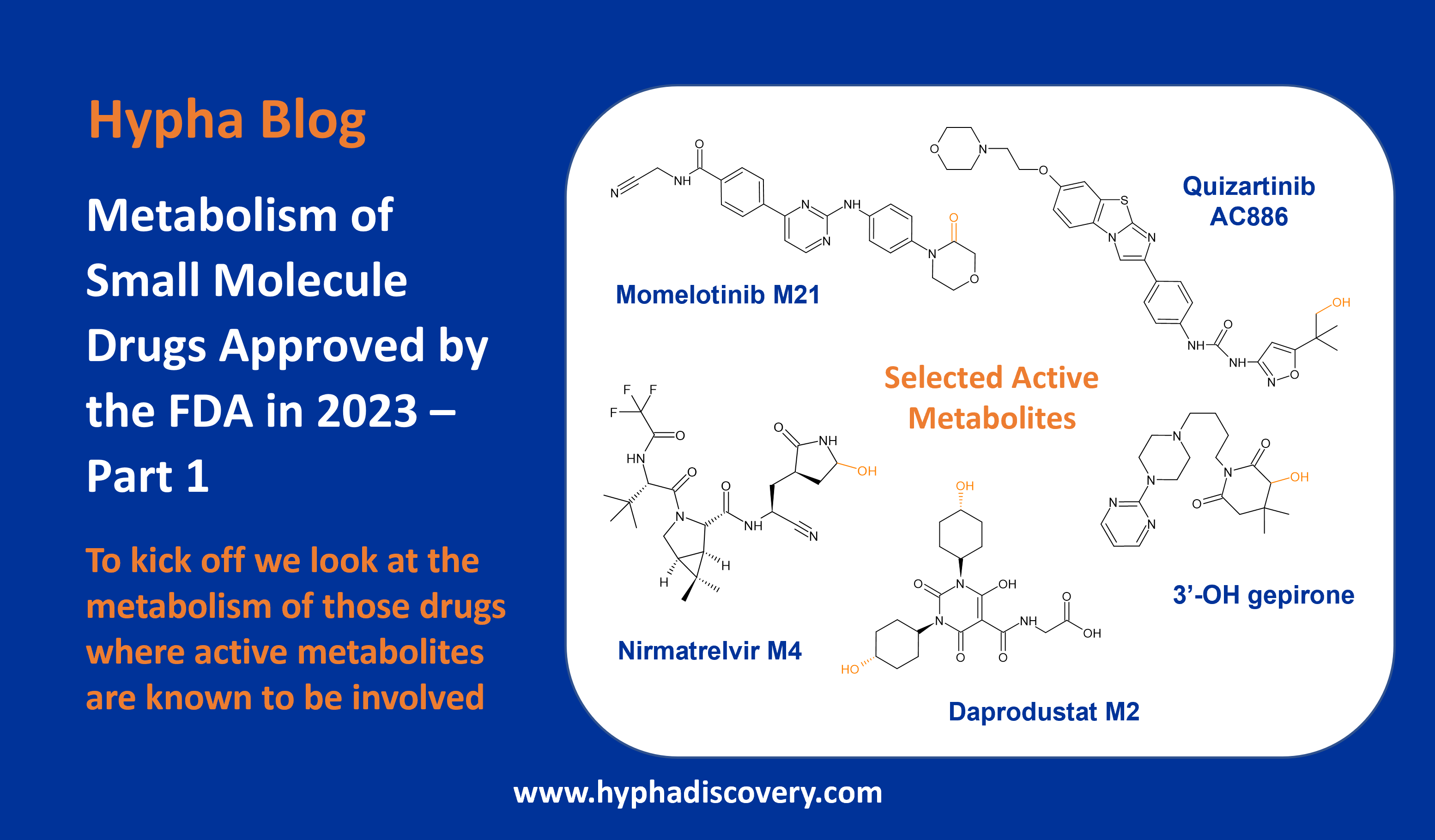Metabolism of nitrogen containing five-membered aromatic heterocycles nitrogen containing five membered aromatic heterocycle
Highlighting trends in oxidation and glucuronidation of these ring systems in drugs
By Samuel Coe
Five membered nitrogen containing aromatic heterocycles are commonly used in medicinal chemistry for multiple reasons, including reduced lipophilicity compared to phenyl groups, increased metabolic stability and ease of substitution.
Bicyclic structures containing five membered rings such as indoles, consisting of a six-membered benzene ring fused to a five-membered pyrrole ring, are also increasingly relevant as growing research fields such as psychedelics make use of these scaffolds, often found in natural products.
Five membered nitrogen containing aromatic heterocycles can be split into those with 1,2,3 or 4 nitrogens. The arrangement of these gives the common name and different physical chemical properties (Table 1). This mix of properties makes azoles very versatile in medicinal chemistry and each tend to have quirks of metabolism that we highlight in this blog. Building on the extensive review by Dalvie et al. that highlighted specific biotransformations of five-membered heteroaromatic rings,1 we have sought to highlight additional examples and recent understanding in their metabolism.
The continued popularity of these different ring systems means that an awareness of their potential routes of metabolism is helpful for medicinal chemists.
Table 1: Data from J. Med. Chem. 2012, 55, 6002-6020 (https://doi.org/10.1021/jm300343m)

Pyrroles as targets for oxidation
Pyrroles are extensively metabolised by cytochrome P450s with oxidation preferred on the carbons adjacent to the nitrogen. This oxidation is facilitated through opening of the corresponding epoxide in an analogous manner to the generation of phenols in phenyl rings, with the tautomerized pyrrolidinones able to undergo additional oxidation (Figure 1).2

Figure 1
Not only does the carboxylic acid moiety of the infamous drug zomepirac undergo conjugation to an unstable acyl glucuronide, the pyrrole undergoes oxidative metabolism to an epoxide intermediate that can be trapped by glutathione (Figure 2).2a

Figure 2
Also reported are more complex “per-oxidative” oxidations. These result in ring opening of the pyrrole.3 Furthermore, due to the reactive nature of the nitrogen lone pair, distally hydroxylated methyl groups can undergo elimination to produce reactive and potentially toxic electrophilic intermediates.3

Figure 3
More recently proteins adducts have been shown to form from semi saturated bicycles containing pyrrole moieties, that presumable work via these intermediates (Figure 3).4
Pyrroles in fused ring systems can also be susceptible to oxidation, such a baricitinib’s pyrrolopyrimidine ring system where oxidative ring opening of the pyrrole ring by CYP3A4 leads to oxidative decarboxylation to (Figure 4).4a

Figure 4 CY3A4 mediated oxidation of baricitinib
Indoles
Indoles have the potential to be oxidised extensively by P450s with example indole-containing drugs are shown below.

Aromatic hydroxylation of the phenyl ring is the most common route of metabolism, with the 5/6 positions preferred over the 4/7. As you would expect, the substitution of the indole will greatly influence which position is metabolised and the electronic contributions of the substituents can be used to predict the likely site.5 Once oxidation has taken place the resulting phenols can be cleared via Phase II conjugation. In contrast to pyrroles that are primarily metabolised at the 2 position, indoles are most electron rich at C-3 and therefore preferentially form the 3-hydroxyl-indole.
In a radiolabelled rat liver microsome study, formation of the 2-hydroxyl-indole and resulting oxindole did not undergo further oxidation. In contrast, 3-hydroxy-indole was shown to be capable of further oxidation to the isatin that can subsequently undergo ring scission.6 Oxidation of pendant methyl groups can result in reactive intermediates, following a similar activation route to the pyrroles.

Figure 5 Highlighting the ring scission pathway of indoles
The P450 mechanisms are well known but there are also potential per-oxidative routes. For example, tryptophan and indoleamine dioxygenases are known to use superoxide to oxidise tryptophan and indoleamines respectively. Additionally, metabolism of the nitrogen can result in simple dealkylations and N-glucuronide formation.7
Whilst Figure 5 illustrates the extensive metabolism that indole rings can undergo, even the addition of a single methyl group could add significant complexity to the metabolism picture of potential drugs.
Azoles – more oxidative ring opening
Whilst indoles and pyrroles are electron rich heterocycles and therefore the predominate route of metabolism is ring oxidation, heterocycles with two heteroatoms can undergo both reductive and oxidative metabolisms.

Figure 6 General oxidative ring opening of azoles
Similarly to CYP mediated formation of epoxides in pyrroles and indoles, azoles are also able to undergo this route of metabolism. This results in ring opening to 1,2 dicarbonyls and the respective amide/imide/thio-amide partner (Figure 6).
Bioactivation of imidazoles
A nice example illustrating the proposed ring scission pathway, as well as conjugative metabolism routes, is shown in the bioactivation of the imidazole ring in LY3031207 (Figure 7).8

Figure 7 Bioactivation of LY3031207
Once bio-transformed to an activated epoxide by P450s, the ring scission cascade results in the formation of an acyl guanidine moiety. The accumulation of this guanidine was used as a marker for this route of metabolism, allowing medicinal chemists to establish SAR for this metabolic route.8 Interestingly, modification of this scaffold in an attempt to block the epoxide formation did not prevent bioactivation. Instead a competing metabolic route was identified. GSH addition to the imine formed by a-aliphatic activation was observed and is analogous to the pathway seen in the pyrrole section (Figure 8).

Figure 8
In addition to the ring scion route of metabolism seen above, CYP-mediated metabolism of imidazole containing drugs focusses on the C2, producing an imidazoline that can subsequently be oxidised to hydantoin and N-(carboxyethyl)urea (Figure 9).1

Figure 9
These initial hydroxylated derivatives can be conjugated as part of a 2-step process, however, direct N-glucuronidation of imidazole derivatives is also possible although sterics tend to influence which nitrogen is conjugated (Figure 10).

Figure 10
Oxazoles and thiazoles

Oxazoles do not appear to have any specific metabolism quirks beyond those seen for imidazoles. Thiazoles are more interesting because thio-amides and thio-ureas are all potential structural alerts and the formation can be linked to bioactivation of thiazoles.9 The evidence here is that treatment with P450 inhibitors removed the toxic effects seen in the compounds of interest.10 The ring opening of thiazoles also offers the opportunity for further derivatisation by S-methyl-transferases that can then undergo additional oxidation leading to a variety of metabolites (Figure 11).11

Figure 11
Pyrazoles – more stable to oxidative cleavage?

While pyrazoles seem to be stable to oxidative cleavage, this ring can still be oxidised, particularly by CYP2E1 in humans.12 Furthermore, pyrazoles are inducers of CYP2E1, thus potentially speeding up the oxidation. Dosing of [3,4-14C]pyrazole to rats resulted in excretion of a variety of metabolites in the urine, including the N-glucuronide (Figure 12).13

Figure 12
N-substituted pyrazoles are also prone to N-dealkyation (Figure 13).14

Figure 13 N-dealkylation
As an alternative route of oxidative metabolism, pyrazoles can be subject to N-glucuronidation, exemplified by 2 of the 3 N-glucuronides observed in metabolism studies of JNJ-10198409, catalysed by multiple UGT1A enzymes.14b

Figure 14 All three N-glucuronides of JNJ-10198409 were detected in rat liver microsomes. Only Glu-A and -B were found in monkey and human liver microsomes.
Isoazoles and Isothiazoles
In contrast to pyrazole, the other iso-azoles do undergo ring opening. This process can be mediated by aldehyde oxidase or cytochrome P450s.

Figure 15
Examples of this route of metabolism are zonisamide (Figure 15) and risperidone.15 Additionally the S-methyltransferase pathway mentioned earlier can also come into play with thiazoles.16
Triazoles

The two isomers of triazole are primarily eliminated as N-glucuronides, with the least hindered nitrogen most likely to be glucuronidated.17a,b Ring oxidation is rare, possibly because many triazole containing drugs are P450 inhibitors.
Although the major metabolite of estazolam is 4-hydroxyestazolam, a minor triazolone metabolite of estazolam has been disclosed18a while the commercial fungicide tebuconazole is proposed to undergo ring cleavage by Meruliporia incrassate, a wood degrading fungus.18b
Oxadiazoles and thiadiazoles
Oxadiazoles are known ester bioisosteres whereas thiadiazols is an emerging scaffold that is seeing applications in a variety of medicinal chemistry programs.19 One interesting rat study with 14C GDC-0152 highlights the potential for this ring to be oxidatively ring opened after initial amide hydrolysis.20 The thiadiazol moiety can undergo initial oxidation to form either the epoxide or S-oxide. Once both have formed, lone pair push from the pendant amine can induce loss of N2, eventually resulting in a benzoic acid derivative. In the study illustrated in Figure 16, where 14C labelling of the benzene ring, enabled detection of a hippuric acid derivative, substantiating the proposed metabolic pathway.

Figure 16
Tetrazoles, last but not least
Tetrazoles are well established carboxylic acid bioisosteres and are extremely resilient to oxidation. Chemical oxidation is only possible with such forcing conditions as hypofluorous acid generated with fresh F2 gas.21 That being the case, the main route of metabolism is conjugation with glucuronidation at the N-1 or N-2 nitrogen.1 One of the main routes of metabolism of losartan is to a tetrazole-N2-glucuronide, in addition to CYP mediated oxidation to an active carboxylic acid metabolite via an aldehyde intermediate (Figure 17). The active metabolite is considerably more potent than the parent drug and has a longer half-life.22

Figure 17
Conclusion
We hope you find this vignette on the metabolism of five membered nitrogen containing heterocycles a useful resource. There is much to be learnt from the pathways described above but in general, the more nitrogens present in your ring, the less likely you are to see Phase I type oxidations of the ring itself. Instead, be on the lookout for N-glucuronides.
References
1 Chem. Res. Toxicol. 2002, 15, 3, 269–299 https://doi.org/10.1021/tx015574b
2 Chem. Res. Toxicol., 2017, 30, 1, 13–37 https://doi.org/10.1021/acs.chemrestox.6b00256
2a Drug Metab. Dispos. 2006, 34, 145-51 http://doi.org/10.1124/dmd.105.004341
3 Drug Metab. Dispos. 1980, 8, 34-38 https://dmd.aspetjournals.org/content/8/1/34
4 J. Food Drug Anal. 2018, 26, 965-972 https://doi.org/10.1016/j.jfda.2018.05.005
4a Pharmaceutics, 2022, 14, 1001 https://doi.org/10.3390/pharmaceutics14051001
5 Phys. Chem. Chem. Phys., 2000, 2, 195-201 https://doi.org/10.1039/A908362F
6 Biochem. J. 1966 98, 266-277 https://www.ncbi.nlm.nih.gov/pmc/articles/PMC1264825/pdf/biochemj00759-0282.pdf
7 Metabolites. 2023, 13, 1, 92- https://doi.org/10.3390/metabo13010092
8 J. Med. Chem. 2018, 61, 5, 2041–205 https://doi.org/10.1021/acs.jmedchem.7b01806
9 ACS Chem. Biol. 2019, 14, 2, 142–16 https://doi.org/10.1021/acschembio.8b01022
10 Chem. Res. Toxicol. 1993, 6, 2, 174–179 https://doi.org/10.1021/tx00032a006
11 Xenobiotica. 1991, 21, 1179-1183. https://doi.org/10.3109/00498259109039558
12 Biochim. Biophys. Acta. 1990, 1034, 233-237 https://doi.org/10.1016/0304-4165(90)90082-8
13 Metabolism of pyrazole in the Rat https://www.elsevier.com/books/alcohol-and-aldehyde-metabolizing-systems/thurman/978-0-12-691403-0
14 Drug Metab. Dispos. 1985, 13, 139-147 https://dmd.aspetjournals.org/content/13/2/139
14b Drug Metab. Dispos. 2006, 34,748-755 https://doi.org/10.1124/dmd.106.009274
15 Drug Metab. Dispos. 2003, 31, 1240-1250 https://doi.org/10.1124/dmd.31.10.1240
16 Drug Metab. Dispos. 1997, 25, 863-872 https://dmd.aspetjournals.org/content/25/7/863.long
17a Drug Metab. Dispos. 1994, 22, 651-658 https://dmd.aspetjournals.org/content/22/4/651
17b Drug Metab. Dispos. 1994, 22, 659-662 https://dmd.aspetjournals.org/content/22/4/659
18a Xenobiotica, 1986, 16, 11-20 https://doi.org/10.3109/00498258609043501
18b Wood and Fibre Science. 2009, 41, 157-167 https://wfs.swst.org/index.php/wfs/article/view/1264
19 Molecules. 2020, 25, 4309 https://doi.org/10.3390/molecules25184309
20 Drug Metab. Dispos. 2013, 41, 508-517 https://doi.org/10.1124/dmd.112.047019
21 J. Org. Chem. 2010, 75, 9, 3141–3143 https://doi.org/10.1021/jo100278z
22 Clin Pharmacokinet. 2005. 44, 797–814 https://doi.org/10.2165/00003088-200544080-00003


